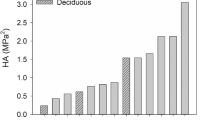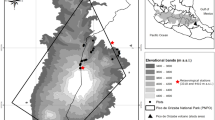Abstract
We aimed to identify marker traits indicating the functional types of plants in the European Northeast. We try to answer the following questions. Which ecological factors make the largest contribution to identifying the functional types of plants in the North and can CO2-exchange and related traits be used as markers? The data were collected from 1000-km latitudinal gradient across middle, north, and far north boreal forests in the east border of Europe. Comparative analysis of 102 species from 36 plant families enabled us to determine the marker traits indicating plant functional types. Competitor species have maximal plant height, comparatively low leaf dry matter content (LDMC), and accumulate high amounts of nitrogen in leaves. These species also have comparatively high photosynthetic and respiration rates. Ruderal species have low values of LDMC, and maximal photosynthetic rate, respiration rate, and photosynthetic nitrogen-use efficiency (PNUE). Slow-growing stress tolerators have a low photosynthetic rate, low respiration rate, and low levels of nitrogen and PNUE. The specific leaf area (SLA) of these plants shows a highly significant correlation with the light regime. In the boreal zone, SLA was found to be more closely related to light availability than to the plant functional type, indicating that SLA is unsuitable for use as a marker trait. We found strong correlations between plant height, respiration rate, and photosynthetic activity and soil nutrition according to Ellenberg values. Soil mineral element contents and acidity were found to have a significant influence on the functional types of plants.


Similar content being viewed by others
References
Ahmetzhanova AA, Onipchenko VG, Elkanova MH et al (2011) Changes in eco-morphological parameters of alpine plants’ leaves as an effect of fertilization. Biol Bull Rev 72(5):388–400
Angelstam P, Dönz-Breuss M, Roberge J (2004) Targets and tools for the maintenance of forest biodiversity: an introduction. Ecol Bull 51:11–24
Caccianiga M, Luzzaro A, Pierce S, Ceriani RM, Cerabolini B (2006) The functional basis of a primary succession resolved by CSR classification. Oikos. https://doi.org/10.1111/j.0030-1299.2006.14107.x
Czerepanov SK (1995) Vascular plants of Russia and adjacent states (the former USSR). Cambridge University Press, New York
Dalke IV, Golovko TK (2011) Photosynthesis and respiration of the boreal zone plants. Vestnik instituta biologii Komi NC UrO RAN 7–8(165–166):5–9 (In Russ.)
Degteva S (2006) Plant communities. In: Taskaev AI (ed) Virgin forests of Komi. The UNESCO world cultural and natural heritage site. Publishing Centre Design. Information. Cartography, Moscow, pp 88–116
Degteva SV, Novakovskii AB (2010) Groups of coupled species in the vegetation cover in the landscapes of the basins of the upper and middle courses of the Pechora river as indicators of ecotopic and phytocenotic conditions. Contempor Probl Ecol 3(2):203–209
Degteva SV, Novakovskiy AB (2012) Jekologo-cenoticheskie gruppy sosudistyh rastenij v fitocenozah landshaftov bassejna verhnej i srednej Pechory [Eco-cenotic groups of vascular plants in phytocenoses of landscapes of the upper and middle Pechora basin]. Ekaterinburg: Uro RAN (In Russ.)
Diaz S, Kattge J, Cornelissen JHC et al (2016) The global spectrum of plant form and function. Nature. https://doi.org/10.1038/nature16489
Ellenberg H (1974) Zeigerwerte der Gefässpflanzen Mitteleuropas. Goltze, Göttingen
Evans JR (1989) Photosynthesis and nitrogen relationships in leaves of C3 plants. Oecologia 78(1):9–19. https://doi.org/10.1007/BF00377192
Evans JR, Seemann JR (1989) The allocation of protein nitrogen in the photosynthetic apparatus: costs, consequences, and control. In: Briggs WR (ed) Photosynthesis. Liss, New York, pp 183–205
Grime JP (1974) Vegetation classification by reference to strategies. Nature 250(5461):26. https://doi.org/10.1038/250026a0
Grime JP (1977) Evidence for the existence of three primary strategies in plants and its relevance to ecological and evolutionary theory. Am Nat 111(982):1169–1194
Grime JP (2006) Plant strategies, vegetation processes, and ecosystem properties. Wiley, Chichester, New York, Weinhein, Brisbane, Singapore, Toronto
Grime JP, Hunt R (1975) Relative growth rate: its range and adaptive significance in a local flora. J Ecol 63:393–422. https://doi.org/10.2307/2258728
Grime JP, Hodgson JG, Hunt R (1988) Comparative plant ecology: a functional approach to common British species. Springer, Amsterdam
Grime JP, Thompson K, Hunt R et al (1997) Integrated screening validates primary axes of specialisation in plants. Oikos 79:259–281. https://doi.org/10.2307/3546011
Gross N, Suding KN, Lavorel S (2007) Leaf dry matter content and lateral spread predict response to land use change for six subalpine grassland species. J Veg Sci 18(2):289–300. https://doi.org/10.1111/j.1654-1103.2007.tb02540.x
Hills JM, Murphy KJ, Pulford ID, Flowers TH (1994) A method for classifying European riverine wetland ecosystems using functional vegetation groups. Funct Ecol 8:242–252. https://doi.org/10.2307/2389908
Hodgson JG, Wilson PJ, Hunt R et al (1999) Allocating C–S–R plant functional types: a soft approach to a hard problem. Oikos 85(2):282–294. https://doi.org/10.2307/3546494
Hunt R, Cornelissen JHC (1997) Components of relative growth rate and their interrelations in 59 temperate plant species. New Phytol 135:395–417. https://doi.org/10.1046/j.1469-8137.1997.00671.x
Lambers H, Poorter H (1992) Inherent variation in growth rate between higher plants: a search for physiological causes and ecological consequences. Adv Ecol Res 23:188–261. https://doi.org/10.1016/S0065-2504(08)60148-8
Larcher W (2003) Physiological plant ecology. Springer, Berlin, Heidelberg, New York
Lavorel S, McIntyre S, Landsberg J, Forbes TDA (1997) Plant functional classifications: from general groups to specific groups based on response to disturbance. Trends Ecol Evol 12:474–478. https://doi.org/10.1016/S0169-5347(97)01219-6
Maslova SP, Tabalenkova GN, Golovko TK (2010) Respiration and nitrogen and carbohydrate contents in perennial rhizome-forming plants as related to realization of different adaptive strategies. Russ J Plant Physiol 57(5):631–640. https://doi.org/10.1134/S1021443710050055
May RL, Warner S, Wingler A (2017) Classification of intra-specific variation in plant functional strategies reveals adaptation to climate. Ann Bot. 119(8):1343–1352. https://doi.org/10.1093/aob/mcx031
Novakovskiy AB, Elsakov VV (2014) Hydrometeorological database (HMDB) for practical research in ecology. Data Sci J 13:57–63. https://doi.org/10.2481/dsj.IFPDA-10
Novakovskiy AB, Maslova SP, Dalke IV, Dubrovskiy YA (2016) Patterns of allocation CSR plant functional types in Northern Europe. Int J Ecol. https://doi.org/10.1155/2016/1323614
Osnas JLD, Lichstein JW, Reich PB, Pacala SW (2013) Global leaf trait relationships: mass, area, and the leaf economics spectrum. Science 340:741–744. https://doi.org/10.1126/science.1231574
Perez-Harguindeguy N, Diaz S, Garnier E et al (2013) New handbook for standardised measurement of plant functional traits worldwide. Aust J Bot 61(3):167–234. https://doi.org/10.1071/BT12225
Pierce S, Brusa G, Vagge I, Cerabolini BEL (2013) Allocating CSR plant functional types: the use of leaf economics and size traits to classify woody and herbaceous vascular plants. Funct Ecol 27:1002–1010. https://doi.org/10.1111/1365-2435.12095
Pierce S, Negreiros D, Cerabolini BEL, Kattge J, Diaz S et al (2017) A global method for calculating plant CSR ecological strategies applied across biomes world-wide. Funct Ecol 31(2):444–457. https://doi.org/10.1111/1365-2435.12722
Poorter H, Bergkotte M (1992) Chemical composition of 24 wild species differing in relative growth rate. Plant Cell Environ 15(2):221–229. https://doi.org/10.1111/j.1365-3040.1992.tb01476.x
Poorter H, Evans JR (1998) Photosynthetic nitrogen-use efficiency of species that differ inherently in specific leaf area. Oecologia 116(1–2):26–37. https://doi.org/10.1007/s004420050560
Poorter H, Pepin S, Rijkers T et al (2006) Construction costs, chemical composition and payback time of high- and low-irradiance leaves. J Exp Bot 57(2):355–371. https://doi.org/10.1093/jxb/erj002
P’yankov VI, Ivanov LA (2000) Biomass allocation in boreal plants with different ecological strategies. Russ J Ecol 31(1):1–7. https://doi.org/10.1007/BF02799718
P’yankov VI, Ivanov LA, Lambers H (2001) Plant construction cost in the boreal species differing in their ecological strategies. Russ J Plant Physiol 48(1):67–73. https://doi.org/10.1023/A:1009002715572
Ramenskiy LG (1935) O principial’nyh ustanovkah, osnovnyh ponjatijah i terminah proizvodstvennoj tipologii zemel’, geobotaniki i ekologii. Soviet Bot 4:25–42 (In Russ.)
Reich PB (2014) The world-wide ‘fast–slow’ plant economics spectrum: a traits manifesto. J Ecol 102:275–301. https://doi.org/10.1111/1365-2745.12211
Shipley B (2002) Trade-offs between net assimilation rate and specific leaf area in determining relative growth rate: relationship with daily irradiance. Funct Ecol 16(5):682–689. https://doi.org/10.1046/j.1365-2435.2002.00672.x
Smart SM, Glanville HC, Blanes MC et al (2017) Leaf dry matter content is better at predicting above-ground net primary production than specific leaf area. Funct Ecol 31:1336–1344. https://doi.org/10.1111/1365-2435.12832
Wilson PJ, Thompson K, Hodgson JG (1999) Specific leaf area and leaf dry matter content as alternative predictors of plant strategies. New Phytol 143:155–162. https://doi.org/10.1046/j.1469-8137.1999.00427.x
Acknowledgements
The authors thank Professor Tamara Golovko and Professor Svetlana Degteva for their critical comments. The research was supported by the Russian Foundation for Basic Research and Government of Komi Republic (18-44-110015), project “Physiology and stress tolerance of plants and poikilohydric photoautotrophs in the North” (AAAA-A17-117033010038-7), Programs of the Ural Branch of RAS (18-4-4-20, 18-4-4-14), and by the project “Structural and functional patterns of plant communities, diversity of flora, lichen and mycobiota of the southern part of the national park “Yugyd va” (AAAA-A16-116021010241-9). We would like to thank Editage (www.editage.com) for English language editing.
Author information
Authors and Affiliations
Corresponding author
Additional information
Communicated by Sandor Bartha.
Electronic supplementary material
Below is the link to the electronic supplementary material.
Rights and permissions
About this article
Cite this article
Dalke, I.V., Novakovskiy, A.B., Maslova, S.P. et al. Morphological and functional traits of herbaceous plants with different functional types in the European Northeast. Plant Ecol 219, 1295–1305 (2018). https://doi.org/10.1007/s11258-018-0879-2
Received:
Accepted:
Published:
Issue Date:
DOI: https://doi.org/10.1007/s11258-018-0879-2




